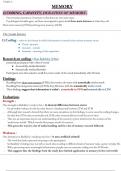Samenvatting
Summary Probability and Statistics for International Business Administration, lecture notes
- Instelling
- Universiteit Twente (UT)
Lecture notes of all the Probability lectures given by K. Poortema in BOM (module 2 of IBA at the UT). Includes all the useful formulas and explanations.
[Meer zien]






